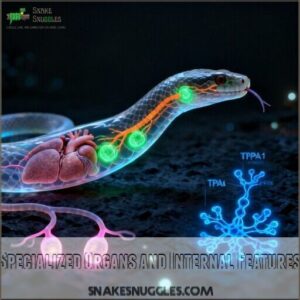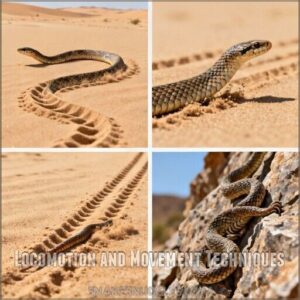This site is supported by our readers. We may earn a commission, at no cost to you, if you purchase through links.

From heat-sensing pits that detect warm-blooded prey in darkness to flexible skulls that swallow meals wider than their own heads, snakes possess characteristics that challenge our assumptions about what a successful vertebrate needs. Their sensory systems read chemical signatures through forked tongues, their scales create friction patterns for climbing vertical surfaces, and their skeletal structure—sometimes exceeding 400 vertebrae—allows movement through spaces that would trap most animals.
Understanding these adaptations reveals how environmental pressures sculpted one of nature’s most specialized body plans.
Table Of Contents
- Key Takeaways
- Snake Evolution and Natural History
- Snake Anatomy and Physical Traits
- Snake Skin, Scales, and Coloration
- Sensory Systems and Communication
- Locomotion and Movement Techniques
- Habitats and Environmental Adaptations
- Feeding Habits and Hunting Strategies
- Reproduction and Life Cycle
- Defense Mechanisms and Human Interactions
- Frequently Asked Questions (FAQs)
- How do snakes move?
- Do snakes have ears?
- How fast do snakes grow?
- What is molting in snakes?
- What physical trait sets snakes apart from other reptiles?
- What are 5 characteristics of snake?
- What are snake like personality traits?
- What characteristics does a snake represent?
- What are 5 interesting facts about snakes?
- How do snakes interact with other animals?
- Conclusion
Key Takeaways
- Snakes evolved from lizard ancestors through limb loss and body elongation, resulting in highly flexible spines with 200-400 vertebrae that enable them to navigate tight spaces and diverse terrains—from deserts to oceans—making limblessness an evolutionary advantage rather than a limitation.
- Their sensory systems go far beyond vision, using forked tongues paired with vomeronasal organs for chemical tracking, heat-sensing pits that detect thermal signatures in darkness, and inner ear bones that pick up ground vibrations through jaw contact, creating a complete spatial awareness system.
- Snake feeding strategies split into two specialized approaches: venomous species deliver toxins through hollow fangs for rapid prey immobilization, while constrictors use muscular coils to induce circulatory arrest, with both methods supported by independently articulating jaw bones that allow swallowing prey larger than their head diameter.
- Conservation pressures threaten over 21% of snake species due to habitat destruction and illegal wildlife trade, with projections showing 71% of threatened snake ranges overlapping human settlements by 2050, requiring habitat preservation and cultural perception shifts to recognize their ecological value as pest controllers.
Snake Evolution and Natural History
To understand snakes as they’re today, it helps to know where they came from and how they changed over millions of years. Their story is one of transformation, shaped by ancient ancestors and survival in shifting worlds.
Let’s walk through the key milestones that mark their evolutionary path.
Origins From Lizard Ancestors
If you’ve ever wondered where snakes first slithered onto the scene, their story begins deep in the shadows of prehistory—when ancient lizards started down an evolutionary path that would change their bodies forever.
Through a perfect storm of:
- Lizard Ancestry
- Fossil Evidence
- Limb Loss
- Body Elongation
- Genetic Changes
These transformations shaped snake evolution, snake anatomy, and snake characteristics through extraordinary evolutionary adaptations.
Fossil Record Highlights
Looking back through the fossil record, you’ll find milestones that anchor the evolutionary timeline of snakes—from the Oldest Snake Fossils, like Eophis underwoodi in Jurassic England, to Key Fossil Discoveries spanning continents.
These ancient traces reveal snake anatomy in flux: bodies growing longer, limbs fading, and varied Fossil Snake Morphology already hinting at adaptation to diverse Ancient Snake Habitats.
The discovery of fossils like Eophis underwoodi has helped identify the oldest known snake.
Key Evolutionary Adaptations
Over millions of years, snakes refined a suite of physical changes—losing limbs, stretching their bodies, and remodeling their skulls—that turned them into some of the most specialized predators on Earth. These evolutionary adaptations opened new ecological niches and shaped their survival:
- Limb loss and body elongation freed them to slip through tight spaces unseen.
- Skull mobility let jaws stretch wide, swallowing prey whole.
- Eye adaptation and venom evolution sharpened their ability to hunt and defend.
Each genetic modification carved out a place for snakes in habitats others couldn’t reach.
Snake Anatomy and Physical Traits
When you look at a snake, you’re seeing the result of millions of years of precise anatomical refinement. Their bodies showcase striking adaptations that allow them to thrive without limbs in nearly every environment on Earth.
Let’s examine the specific physical traits that make snakes such successful predators and survivors.
Body Shape and Size Variations
Snakes exhibit remarkable diversity in size and body proportions, ranging from thread-thin blind snakes barely longer than a pencil to massive anacondas that can weigh as much as a grown man. Their body structures are finely tuned to their hunting grounds and prey. Slender arboreal species maneuver through branches with ease, while sturdy constrictors overpower large mammals. Sexual dimorphism is common, with females typically larger to accommodate eggs.
Regional variation and environmental pressures drive size extremes across populations.
| Size Category | Representative Species | Typical Length |
|---|---|---|
| Miniature | Barbados Threadsnake | 4 inches |
| Small | Ringneck Snake | 10-15 inches |
| Medium | Corn Snake | 3-5 feet |
| Giant | Reticulated Python | 20+ feet |
Limbless Structure and Skeletal Adaptations
The absence of limbs distinguishes snakes from their lizard relatives, yet this loss wasn’t a setback—it was a radical skeletal redesign that unlocked new ecological niches.
Your typical snake possesses 200 to 400 vertebrae, each bearing movable ribs that create a flexible spine for fluid motion. Skull flexibility evolved alongside limb reduction, allowing snakes to manipulate prey larger than their heads.
Some species retain pelvic remnants—small vestigial bones hinting at their legged ancestry. This limbless structure revolutionized how reptiles navigate tight spaces and subdue prey.
Specialized Organs and Internal Features
Beneath that sinuous exterior lies an arrangement of organs you won’t find in other reptiles. Your typical snake has a three-chambered heart and a renal portal system routing blood through the kidneys—a unique circulatory feature.
Venom glands in venomous species activate specialized stress pathways during toxin production, while infrared pits in some species house TRPA1 ion channels for heat detection.
Organ arrangement varies dramatically; some retain elongated left lungs, others reduce or lose them entirely. Recently, scientists discovered hemiclitores—bifurcated erectile structures in females—challenging assumptions about snake anatomy and reproductive biology. This discovery marks the first scientific description of snake hemiclitores anatomy.
Snake Skin, Scales, and Coloration
A snake’s outer covering does more than protect—it reveals where the animal lives, how it hunts, and whether it poses a threat. The arrangement of scales, the intensity of colors, and the patterns that emerge all serve specific biological functions.
You’ll discover how these features work together to guarantee survival across vastly different environments.
Scale Types and Arrangements
If you’ve ever run your hand along a snake’s body, you know the texture isn’t uniform—those overlapping plates covering every inch of skin vary in shape, size, and function depending on where they sit. Dorsal scales along the back provide protection and aid movement, while ventral scales underneath grip surfaces during locomotion.
These keratin scales differ in morphology across species, making identification by scale characteristics a reliable method for taxonomists. Modified scales even form specialized structures like heat-sensing pits or rattles, showcasing how scale evolution shaped survival strategies.
Camouflage and Aposematic Patterns
When survival hinges on visibility—or the lack of it—you’ll find snakes have mastered two opposing strategies: blending into the background so completely they vanish, or flaunting bold, unmistakable colors that scream danger from a distance.
Snake coloration and camouflage patterns serve distinct evolutionary advantages:
- Cryptic camouflage uses earth tones and pattern disruption to fragment body outlines against substrate
- Aposematic coloration employs high-contrast bands warning predators of venom delivery systems
- Batesian mimicry types allow harmless species to copy dangerous models for predator avoidance
- Adaptive color change occurs seasonally in some populations, matching shifting environmental backgrounds
These snake patterns directly influence survival rates in wild populations.
Shedding and Skin Renewal
Unlike most external features, a snake’s skin isn’t permanent—it’s a temporary covering that gets replaced entirely through a process called ecdysis, where the old layer peels away in one continuous piece to reveal fresh scales beneath.
Shedding frequency depends on growth rate, age, and health—juveniles shed every few weeks, while adults may only need scale regeneration a few times yearly.
The ecdysis process involves fluid buildup between skin layers, temporarily clouding your snake’s eyes before the outer layer detaches. This shedding mechanism also helps heal wounds and remove parasites.
Sensory Systems and Communication
Snakes navigate their world through a complex array of sensory adaptations that far exceed simple sight and sound. These specialized systems allow them to detect chemical signals, sense thermal radiation, and perceive vibrations with impressive precision.
Understanding how snakes gather information from their environment reveals the elegant solutions evolution has crafted for a limbless, ground-dwelling predator.
Forked Tongue and Scent Detection
You mightn’t realize it, but a snake’s forked tongue is actually one of the most complex chemical detection systems in the animal kingdom.
Through rapid tongue flicking, snakes collect chemical signals from the air and ground, transferring them to the vomeronasal organ in the roof of their mouth.
This specialized sensory perception allows precise prey detection and scent trailing, with each fork independently sampling molecules to determine directional information critical for snake behavior and communication.
Vision and Heat-Sensing Pits
Snake eyes work differently than you might expect. Most species have dichromatic vision with three visual pigments, letting them see two primary colors plus ultraviolet light—helpful in dim conditions.
Eye size varies by lifestyle: arboreal snakes have the largest eyes, while nocturnal species have smaller ones and rely more on infrared detection. Pit-bearing snakes like vipers sense heat through specialized pit organs, detecting thermal patterns above 30°C within five centimeters. This infrared detection creates a thermal image, enabling precise strikes in complete darkness.
The transparent spectacle protecting each eye also varies—thicker in some families, larger in tree-dwellers—reflecting millions of years of genetic vision adaptations shaped by habitat and activity patterns.
Auditory and Tactile Senses
While snakes lack external ears, their inner ear bones detect ground vibrations through their jaw and belly scales, translating even subtle tremors into spatial awareness that complements their other senses. Bone conduction through the quadrate bone picks up low-frequency sounds, while scale sensitivity across the body registers prey movement.
These sensory receptors transform touch into tactile hunting precision, helping you understand how snake anatomy and morphology create a complete sensory perception system beyond what snake eyes alone provide.
Locomotion and Movement Techniques
Snakes move without limbs through several distinct locomotion methods, each suited to different environments and surfaces.
Understanding how these movement techniques work reveals the striking adaptability of these reptiles. The following methods represent the primary ways snakes navigate their world.
Serpentine and Lateral Undulation
The most common form of snake movement—lateral undulation—creates the signature S-shaped curves you’ve probably noticed as a snake glides across the ground, using each bend of its body to push against irregularities in the surface and propel itself forward.
This serpentine efficiency depends entirely on muscular control coordinating hundreds of ribs and vertebrae in your snake’s elongated body. Substrate influence matters considerably—smooth surfaces reduce effectiveness while textured terrain improves grip.
Speed variations occur based on:
- Muscle coordination along the entire body length
- Surface texture providing necessary resistance points
- Body structure adaptations in different species
- Environmental conditions affecting movement efficiency
These survival strategies showcase striking snake physical traits evolved over millions of years.
Concertina and Sidewinding
Narrow tunnels and loose sand demand entirely different movement mechanics, which is why some species have perfected concertina locomotion—anchoring one section of the body while extending another forward—or sidewinding, where the snake lifts portions of its body off hot or unstable surfaces in a distinctive rolling motion.
Concertina mechanics require substantial energy expenditure but provide evolutionary advantages in confined spaces, while sidewinding efficiency minimizes heat absorption and maximizes traction on shifting substrates.
These specialized snake body structures reflect how terrain impact shapes snake anatomy and morphology, demonstrating nature’s elegant solutions to environmental challenges.
Adaptations for Diverse Terrains
Across scorching dunes, through tangled rainforest canopies, and beneath frigid alpine rocks, evolutionary pressures have sculpted remarkably specialized snake adaptations that transform each terrain from obstacle into opportunity. Terrain-specific morphology reveals how habitat influence drives physical traits—keeled scales grip vertical bark while smooth ventral surfaces glide across sand.
Regional adaptation produces behavioral adaptations like nocturnal activity in deserts, where camouflage and coloration blend seamlessly with substrate hues, reflecting environmental pressures that shape survival strategies across remarkably diverse landscapes.
Habitats and Environmental Adaptations
Snakes have mastered nearly every habitat on Earth, from scorching deserts to dense rainforests and open oceans. Their physical traits and behaviors shift dramatically based on where they live, allowing them to thrive in conditions that would challenge most other reptiles.
Understanding these adaptations reveals how snakes occupy such diverse ecological niches across the globe.
Desert, Forest, and Aquatic Environments
From scorching sands to dense rainforests and freshwater streams, snakes have colonized nearly every imaginable environment on Earth, each habitat sculpting distinct adaptations in body form, coloration, and behavior. Consider how desert adaptations favor heat tolerance and sandy hues for camouflage, while forest camouflage produces green or brown patterning that blends with foliage. Aquatic locomotion relies on flattened tails and valve-like nostrils.
Snake species thrive across these habitats through:
- Desert environments – pale coloration, nocturnal activity, and burrowing behavior
- Forest habitats – arboreal agility, cryptic patterns, and ambush hunting
- Aquatic systems – sleek bodies, specialized scales, and breath-holding capacity
Habitat loss threatens many populations, making conservation efforts critical for preserving snake behavior and defense strategies across diverse ecosystems.
Arboreal and Underground Lifestyles
Whether spiraling through leafy canopies dozens of feet above ground or tunneling beneath the earth’s surface, snakes have mastered vertical extremes that showcase some of nature’s most striking physical specializations. Arboreal snakes display slender builds and prehensile tails for traversing tree branches, while burrowing snakes possess compact heads and reinforced skulls for subterranean adaptations.
This habitat stratification facilitates niche partitioning, reducing competition as species occupy distinct vertical zones within the same ecosystem. Through arboreal locomotion and burrow construction, snakes exploit every available habitat layer.
Climate and Regional Influences
Regional climate dictates snake habitat and distribution through complex ecological niches that shape species richness, venom variation, and activity patterns. Brazil’s Cerrado boasts the highest snake species richness, supporting 222 distinct species, while tropical forests harbor up to 120 species per site.
Climate change drives range shifts, with some venomous species expanding their habitat by 250%, while others face 70% losses by 2070. Temperature and rainfall influence human interactions, particularly snakebite incidence in agricultural regions, where warming extends foraging periods.
Feeding Habits and Hunting Strategies
Snakes have evolved diverse feeding strategies that reflect their ecological niches and physiological capabilities. Your understanding of how these predators locate, capture, and consume prey reveals the striking adaptations that have allowed them to thrive across virtually every terrestrial habitat.
The following sections examine the dietary preferences, hunting methods, and anatomical specializations that define snake feeding behavior.
Prey Selection and Diet
Your local snake isn’t a picky eater by nature—it’s a specialist honed by millions of years of evolution to target prey that matches its hunting style, body size, and habitat.
Snake diet reflects precise dietary adaptations, with carnivorous diets ranging from insects and amphibians to mammals and birds. Prey size matters—you’ll find smaller species consuming invertebrates while larger constrictors tackle deer-sized animals, their hunting strategies perfectly aligned with available food sources and efficient food digestion cycles.
Venomous Vs. Constrictor Feeding
Two fundamental approaches define how snakes secure their meals: venom delivery and constriction mechanics. Over 600 species rely on venom evolution to produce specialized toxins—neurotoxins, cytotoxins, or coagulotoxins—that immobilize prey through hollow fangs, while constrictors use muscular coils to induce circulatory arrest within seconds.
- Venomous snakes strike and release, minimizing contact with dangerous prey
- Constrictors maintain grip throughout subduing, risking injury from retaliation
- Venom production demands ongoing energy expenditure for protein synthesis
- Constriction requires substantial body mass but no depletable biological reserves
These prey immobilization strategies reflect distinct ecological implications: venomous snakes specialize in rapid strikes suited for elusive targets, while constrictors excel at processing larger prey relative to body size.
Jaw Flexibility and Swallowing Mechanisms
Once prey is subdued—whether by venom or coils—you might wonder how a snake accomplishes swallowing animals that appear far too large for its head. The answer lies in cranial kinesis: jaw structures articulate independently rather than fusing at the chin, allowing each side of the mouth anatomy to "walk" over prey alternately.
Contrary to popular belief, jaw dislocation doesn’t occur—the mandibles remain attached via elastic ligaments throughout the swallowing process, while esophagus expansion accommodates prey size exceeding the snake’s diameter.
Reproduction and Life Cycle
Snakes exhibit striking diversity in their reproductive strategies, a reflection of their adaptability across environments. Whether your interest lies in understanding egg-laying species, observing mating rituals, or learning about how young snakes develop, you’ll find that these processes reveal the resilience encoded in serpentine biology.
The following sections outline the three primary aspects of snake reproduction and development.
Egg-Laying Vs. Live Birth
Snakes don’t all bring their young into the world the same way—some lay eggs with protective shells, while others give birth to fully formed, live offspring. These reproductive modes divide snake species into oviparity (egg-laying snakes) and viviparity (live-bearing snakes).
Oviparous species deposit eggs in concealed sites for incubation, relying on environmental warmth. Viviparous species retain developing embryos internally, offering protection in cooler climates where egg incubation might fail—a key adaptation in reptile biology.
Mating Behaviors and Courtship
Before eggs hatch or live young emerge, snakes must first find mates—a process governed by chemical signals, physical displays, and competitive interactions that vary widely across species. Snake mating behaviors reveal fascinating reproductive strategies:
- Pheromone trails guide males to receptive females during breeding season
- Combat rituals between competing males establish dominance through wrestling matches
- Courtship displays involve chin rubbing, body alignment, and tactile stimulation
- Mating balls form when multiple males pursue a single female
- Pair bonding remains brief, focused solely on successful reproduction
These mating rituals facilitate snake attraction and successful courtship across diverse habitats.
Parental Care and Juvenile Development
After mating concludes, most snake species abandon their eggs or young, leaving hatchlings to face the world alone from their first breath. However, some species exhibit exceptional parental investment through nest guarding and egg incubation, protecting developing embryos from predators and environmental threats. Python mothers, for instance, coil around their clutches to regulate temperature—a rare form of brood care in reptile biology.
| Parental Behavior | Snake Species Example |
|---|---|
| Nest Guarding | King Cobras, Pythons |
| Egg Incubation | Ball Pythons, Reticulated Pythons |
| Brood Care (Post-Hatching) | Rare; most provide none |
| Juvenile Feeding | Independent from birth |
Most hatchlings survive without parental investment, relying on instinct to hunt and navigate snake habitats. This independence shapes snake reproduction strategies across diverse ecosystems, influencing snake conservation efforts worldwide.
Defense Mechanisms and Human Interactions
Snakes have evolved impressive defense mechanisms that help them survive encounters with predators and humans alike. Understanding how these reptiles protect themselves—from venom delivery to visual warnings and escape strategies—reveals the intricate balance between their vulnerability and resilience.
We’ll examine three critical aspects: the role of venom and warning coloration, camouflage and escape tactics, and the conservation challenges snakes face alongside their cultural significance.
Venom and Warning Coloration
When a predator encounters a snake, the difference between vivid stripes and muted earth tones can mean the difference between a fatal mistake and a lifesaving retreat. Venomous snakes often display aposematic coloration—bold reds, yellows, and blacks—that advertise their toxicity levels.
These warning signals, paired with defensive postures like coiling or neck-flaring, communicate danger without wasting venom. You’ll find that venom delivery systems vary widely, with color patterns serving as nature’s universal caution tape for would-be attackers.
Camouflage and Escape Tactics
Most snakes rely on remaining unseen rather than warning predators away, blending seamlessly into their surroundings through cryptic coloration and stillness that transforms them into nearly invisible parts of the landscape. You’ll notice desert-dwelling species with sandy hues and forest snakes in green-brown tones—these color patterns exemplify adaptive hiding at its finest.
When threatened, behavioral adaptations in snakes include freezing in place or employing stealth movement to slip away undetected, showcasing concealment strategies refined over millions of years for effective predator avoidance.
Conservation Challenges and Cultural Significance
Beyond immediate survival, snakes face mounting conservation pressures—more than 21% of reptile species are now threatened with extinction, driven by habitat destruction and the illegal trade of nearly 1 million endangered snakes annually. Snake conservation strategies must address human conflict, particularly as 71% of threatened snake ranges are projected to overlap with human settlements by 2050. Conservation efforts require a multifaceted approach, combining habitat preservation with a shift in cultural perceptions.
- Habitat Preservation: Protecting wetlands and reducing habitat fragmentation are essential to sustaining snake populations.
- Snake Trade: Regulatory enforcement is crucial to confront the illegal commerce that threatens their survival.
- Cultural Symbolism: Transforming societal perceptions can honor snakes’ ecological roles as pest controllers and contributors to medical research.
Frequently Asked Questions (FAQs)
How do snakes move?
No exaggeration—watching snakes move is pure poetry in motion. These reptiles rely on muscle movement and body flexion, coordinating hundreds of vertebrates with their belly scales to create friction against surfaces.
Different snake species use distinct slithering techniques and motion patterns depending on terrain.
Do snakes have ears?
Ear structure in snakes differs from other vertebrates—they lack external ear openings and eardrums. Their inner ear connects to the jawbone, detecting ground vibrations. This auditory system allows sound detection through substrate-borne frequencies rather than airborne noise.
How fast do snakes grow?
Growth rates vary widely among snake species, influenced by environmental conditions, feeding frequency, and genetics. Well-fed juveniles in warm climates may grow rapidly, while those with limited food or cooler temperatures develop more slowly.
What is molting in snakes?
Despite appearing permanently sealed in their scales, snakes actually shed their entire outer layer regularly—a process called molting or ecdysis.
This renewal cycle allows for growth and removes parasites and damaged skin.
What physical trait sets snakes apart from other reptiles?
You’ll recognize snakes by their limbless condition and dramatically elongated bodies. Unlike other reptiles, they lack external limbs, movable eyelids, and external ear openings, distinguishing them from lizards, turtles, and crocodiles.
What are 5 characteristics of snake?
Limbless locomotion, lethal venom delivery systems, scaly skin protection, remarkable body flexibility, and specialized heat regulation distinguish snakes.
These physical characteristics and unique adaptations of snakes reflect millions of years refining anatomy for survival across diverse environments.
What are snake like personality traits?
You’ll recognize snake-like personality traits through their stealthy nature and adaptive behavior. These primal traits reflect survival instincts—people who observe carefully before acting, remain elusive when threatened, and rely on keen communication through subtle body language rather than overt displays.
What characteristics does a snake represent?
Like a guardian cloaked in mystery, snakes embody transformation, wisdom, and primal power. Their scaly skin, venom types, and adaptive features reflect survival mastery.
You see reptile traits and snake anatomy shaped by unique adaptations—physical characteristics revealing snake behavior through body structures evolved for countless environments.
What are 5 interesting facts about snakes?
You’ll find that venom diversity among snake species ranges from neurotoxic to hemotoxic compounds, while scale iridescence creates stunning visual effects through microscopic surface structures.
Their heart repositioning ability during feeding allows massive prey consumption—an extraordinary snake adaptation tied to feeding habits.
How do snakes interact with other animals?
You’ll find snakes primarily as predators, controlling prey populations like rodents and insects to maintain ecosystem balance.
They occupy specific ecological niches, avoiding competition while occasionally becoming prey themselves—reinforcing their role in predator-prey dynamics essential for healthy ecosystems.
Conclusion
Imagine if snakes had evolved with legs—they’d lose their desert hunts, their tree-climbing prowess, and their ability to disappear into crevices smaller than your thumb.
Instead, this snake characteristics guide reveals how limblessness became their superpower. From heat-sensing pits to jaw hinges that exemplify "mealtime," every trait aids survival.
You’ve now glimpsed nature’s blueprint for thriving without limbs—a design millions of years in the making, perfected through necessity, and operating flawlessly across six continents.
- https://www.merriam-webster.com/dictionary/visceral
- https://www.nature.com/articles/s41598-020-75048-y
- https://pmc.ncbi.nlm.nih.gov/articles/PMC2855400/
- https://www.science.org/content/article/tiny-organs-grown-snake-glands-produce-real-venom
- https://www.mtholyoke.edu/news/news-stories/research-sheds-light-rare-find-snake-anatomy
















